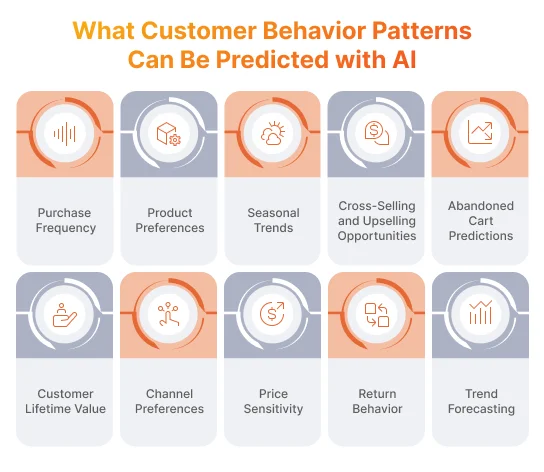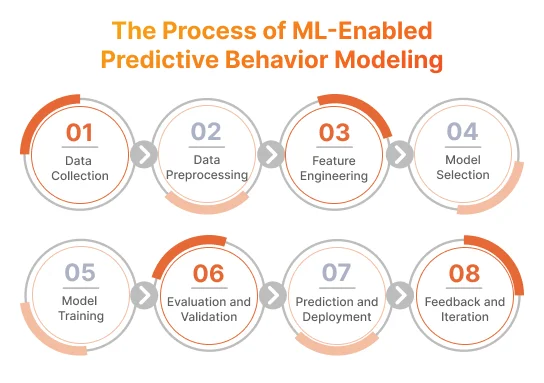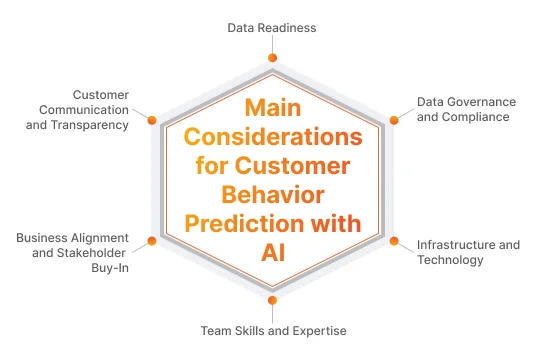Any eCommerce business wins from understanding customer behavior. It provides them with insights into target audience demand, purchasing decisions, or sentiment and helps to adjust sales and marketing strategies. Ultimately, it benefits both customers and businesses: the former gets better service and products, the latter experiences revenue growth.
Big data is now the irreplaceable part of any eCommerce venture, which wants their customer data processed and analyzed. And yet, traditional methods can not handle enormous datasets collected from every customer’s interaction with the online store. However, artificial intelligence (AI) can help eCommerce businesses to overcome this obstacle.
In 2021, the global market for AI in retail was valued at approximately 4.84 billion U.S. dollars. By 2028, the market is expected to reach 31.18 billion U.S. dollars with analytics tools for customer behavior prediction becoming some of the most valuable AI solutions used in retail. Yet, how exactly does retail businesses benefit from predicting customer behavior with AI? We are going to explain how this technology works and what benefits it drives in this article.
What Customer Behavior Patterns Can Be Predicted with AI
Nowadays merchants are willing to know how to build an eCommerce website that fosters customer satisfaction and drives conversion rates. The answer to this is artificial intelligence, which helps to collect and analyze customer data. AI helps identify trends in behavior of customers and allows businesses to address particular customer needs in order to personalize the shopping experience.

Customers interact with online stores in a consistently predictable manner. Therefore, it is possible for AI to accurately predict:
- Purchase Frequency: With the analysis of purchase history, AI is capable of forecasting when a customer will return to buy new products;
- Product Preferences: Browsing behavior and past purchases can be also evaluated by AI to further provide insights into products customers will likely to buy next time.
- Cross-Selling and Upselling Opportunities: Data on previous purchases and browsing history allows AI to understand which products can be suggested to add up to the next purchase.
- Abandoned Cart Predictions: AI can spot the reasons why customers abandon carts. Those reasons can be complex checkout, limited payment or delivery options, and price sensitivity.
- Customer Lifetime Value: AI can identify patterns in customer engagement, buying habits, or purchase frequency rates. Based on that, it offers insights into which customers are more likely to cancel eCommerce subscriptions.
- Channel Preferences: It is possible to investigate how customers respond and react to different marketing efforts, including emails, social media messages, or blog articles. With this, AI can highlight which marketing channels work for which customer segments.
- Price Sensitivity: Behavior analysis done by AI helps to see what customers are price-sensitive, and what products are better to recommend to them.
- Return Behavior: With product return data analyzed, AI can highlight what products have higher chances to be returned. Plus, anomaly detection algorithms used in AI can also suggest when returns look like fraudulent activity.
- Trend Forecasting: By evaluating customer browsing behavior and social media trends, AI can signal what products will be in higher demand in the recent future.
- Seasonal Trends: Seasonal demand fluctuations are often highlighted by AI thanks to analyzing purchase dynamics during holidays, back-to-school seasons, rise of new fashion trends, etc.
Want to know how machine learning works for demand forecasting in retail?
Discover the details in our article!
How AI Works for Customer Behavior Prediction
The process of predicting customer behavior is powered by the combination of predictive analytics and machine learning in retail. Predictive analytics, in its turn, allows for predictive behavior modeling. The latter implies that data scientists and ML engineers build and train machine learning models. Training is done by feeding tons of historical data to models. As a result, models can predict future customer behavior. And once an eCommerce business has prediction data, they can leverage AI for customer segmentation, personalization, dynamic pricing, and predictive retargeting.
To allow customer segmentation, predictive modeling is capable of analyzing customers behavior, demographics, devices used, amounts of money spent for purchases to define separate groups of customers. These groups usually share similar purchasing patterns and preferences. This is why it is possible to later fine-tune marketing efforts or product recommendations in the store based on lifestyle values, spending habits, cultural similarities, etc.
Personalization is proven to drive company revenues by 40% as reported by McKinsey. So, if it is required to equip the business strategy with personalized marketing approaches, predictive modeling can scrutinize individual customer preferences and past behavior types. Those can include frequency and preferences of purchases, search queries, products viewed or abandoned in the cart. With that information, it is possible to craft personalized product recommendations, send targeted marketing messages, and adjust website content and product listings.
Predictive modeling also powers dynamic pricing. To do so, such factors as product demand, competitor prices, or even weather patterns are analyzed to craft adjustments to pricing strategies or come up with limited-time offers and special deals.
Finally, predictive retargeting is also possible thanks to predictive modeling. For that, search, browsing and purchase histories are scrutinized under analysis. In this case, eCommerce businesses are allowed for targeted marketing campaigns such as abandoned cart recovery, win-back campaigns, upselling or cross-selling.

Serhii Leleko
AI&ML Engineer at SPD Technology
“Predictive modeling is extremely valuable for eCommerce. It contributes to understanding customer behavior and adapting to it, which paves the way to more relevant marketing approaches and lead to improved customer satisfaction and business longevity.”
The Process of ML-Enabled Predictive Behavior Modeling
Building predictive behavior models is all about the synergy of quality data and clearly defined goals for behavior analysis. If you want to predict customer behavior for propelling your retail marketing efforts, the following process of developing appropriate models will be a part of eCommerce development services.

Data Collection
The process begins with the collection of relevant data about customer behaviors. This data must be gathered following privacy regulations (e.g. GDPR) to establish the lawful basis for predictive insights on consumer behavior. The following data is usually collected:
- Customer Demographics: Age, location, gender, income;
- Website Activity: Product views, search history, time spent on pages, clicks;
- Purchase History: Products purchased, order value, frequency of purchases;
- Reviews and Ratings: Consumer feedback or customer surveys on products;
- External Data: Social media sentiment, market trends.
Data Preprocessing
When data is collected, it doesn’t mean it is ready for analysis. Moreover, it is considered to be raw and most likely to contain errors or inconsistencies. Therefore, the next step of predictive modeling is preprocessing of this data. This helps to clean and prepare it for analysis. During this stage, data scientists and ML engineers handle missing values, identify and correct errors in data entries, and ensure data is consistent in terms of format and units.
Data cleaning is followed by data normalization or standardization. This technique is responsible for scaling numerical features to a common range. As a result, all features contribute equally to the model’s performance, leading to more accurate predictions for future marketing efforts.
Feature Engineering
Deriving significant characteristics or variables from the raw data to reflect various important aspects of how customers interact with the eCommerce business is the next step in predicting customer behavior. In feature engineering, new variables are made from preexisting data, current features are combined to generate new informative ones, or the most pertinent characteristics that help with the prediction task are selected.
The goal of feature engineering is to create features for models that may be used from data originating from unstructured sources, such as text and images. Using image-to-text and image recognition technologies to eliminate superfluous words and photos from product descriptions was one of our eCommerce initiatives. Our customer was able to expand their product range and boost traffic by 56% by seamlessly incorporating over 1,000,000 products with precise and pertinent item descriptions.
Model Selection
During this stage, ML engineers decide which machine learning models will be the most suitable for customer behavior prediction tasks. For that, they define the nature of prediction tasks (e.g. suggest additional products to buy, include in marketing emails, etc.). Then, they evaluate characteristics of the data. And afterwards, they can finally choose the right algorithms based on the findings from the previous stages.
Some of the commonly used algorithms for predictive behavior modeling include regression models, decision trees, random forests, and neural networks. Below, we describe each of them and highlight their use cases in the context of predicting consumer behavior in eCommerce.
Regression Models
Use Case: Customer Lifetime Value (CLV) Prediction
Regression methods work well for predicting CLV, including logistic and linear regression. These models forecast the total income a customer is anticipated to create over the course of their lifetime with the eCommerce business by analyzing customer data, including historical purchase history, demographics, and product preferences.
Regression models open the following possibilities for the marketing strategy in retail:
- Identifying customers who bring the most value to the business to personalize marketing techniques for their retention;
- Optimizing marketing cost thanks to centering marketing and sales efforts on segments of customers with high CLV;
- Creating reward campaigns or customizing loyalty programs for important clients.
Decision Trees
Use Case: Customer Segmentation
Decision trees can check demographics, purchase history, and website behavior to produce specific rules and criteria for meaningful segmentation. Consequently, segments will contain customers with similar behaviors and preference or purchase characteristics.
Using decision trees for customer segmentation can offer:
- Executing marketing strategies targeted specifically for certain customer segments;
- Creating customized product bundles and upsell/cross-sell tactics for various market categories;
- Designing focused email campaigns that offer pertinent product recommendations for every market segment.
Random Forests
Use Case: Churn Prediction
Login frequency, history of purchases, and interaction with support can be analyzed with random forests. Along with aforementioned customer engagement metrics, these algorithms also evaluate demographics and subscription details among other factors. In such a way, eCommerce companies can get insights into reasons behind subscription cancellation.
With the work of random forests, retailers can fine-tune their marketing efforts to make customers stay thanks to:
- Defining customers who are likely to churn and offering them targeted incentives;
- Offering personalized promotions for at-risk customers;
- Improving customer retention rates and reducing customer acquisition costs.
Neural Networks
Use Case: Customer Purchase Intent Prediction
Deep learning models like neural networks help with detecting purchase intent. They analyze browsing behavior thanks to tracking clicks, time spent on pages, interactions with products, items in abandoned carts to understand what customers prefer. Also, these algorithms provide insights into demographic data, including gender and age. With all the data collected and analyzed, they can indicate whether a customer is likely to purchase a product or not.
Benefits of using neural networks for predicting customer behavior include:
- Displaying personalized product recommendations based on real-time purchase intent;
- Optimizing product placement in the digital store to show only relevant items to customers with high buying intent;
- Reducing cart abandonment rates by offering targeted incentives at the checkout stage.

Serhii Leleko
AI&ML Engineer at SPD Technology
“Choosing the right model to predict behavior requires understanding customers’ goals. We pay attention to data: structured data works well with most models, while unstructured data might need pre-processing. Interpretability is also important. If you need to understand why a customer might churn, simpler models like decision trees are better than complex neural networks.”
Model Training
After data scientists and ML engineers choose the appropriate models, they feed models with the prepared data to learn the patterns and relationships between features and target variables. During training, data is strategically split into two sets: training data (used for model learning) and a testing set (used for evaluation). This split helps to detect overfitting, the case where the model memorizes the training data too well but performs poorly on unseen data.
Next, the types of machine learning models are used to determine which particular training pipeline to choose. In order to maximize performance, hyperparameters, meaning the parameters that govern the behavior of the models, are also changed. In order to reduce prediction errors, models need the modification of their internal parameters after learning patterns from the training set.
Evaluation and Validation
Once trained, the model performance needs to be evaluated. This can be done on the unseen testing data set. Such an approach allows data scientists to see if models can correctly generalize to new data. Also, this helps detect overfitting.
Classification, regression, and AUC-ROC curve are commonly used metrics for evaluating model performance. They are used to check the results of predicting customer categories, numerical values, or assessing model imbalanced datasets respectively. Thanks to evaluation, it becomes possible to see if there are any weaknesses in the models before deployment.
Prediction and Deployment
If the evaluation stage went successfully, and machine learning performs well, it means they are ready for deployment and can be integrated into the eCommerce website. Once deployed, models take in features representing consumer behavior data and output predictions about their future actions or decisions.
There are two main ways this can be used:
- The store can generate real-time predictions, which contributes to personalized recommendations or discounts. With real-time prediction, customers are more likely to take immediate action and buy right away.
- The store can collect numerous predictions and use them for reporting, predicting future trends, or meticulously crafting marketing campaigns.
Feedback and Iteration
Customer behavior is not something stable. Therefore, it is considered essential to monitor models’ performance over time and make adjustments when needed. Moreover, there are also additional factors that come into play and change the eCommerce environment. New merchants that become competitors, new trends that change customer preferences, sudden changes in the global economy that influence purchasing power – all that requires addressing when fine-tuning ML models.
To ensure models provide relevant predictions, you need to monitor their performance based on the feedback loop. It gives you the possibility to find areas for improvement, such as feeding new data for re-training, adjusting hyperparameters, or developing new models to meet your business requirements more efficiently.
Main Considerations Before Customer Behavior Prediction Implementation
eCommerce app development with predictive modeling changes your position on the market for the better. Yet, there is no way you can benefit from knowing how customers behave, personalized experiences, and boosted sales without carefully addressing data quality, compliance, and infrastructure. So, let’s go through the crucial aspects that must be taken into account before setting up ML models for predicting consumer behavior.

Data Readiness
Consumer behavior predictions heavily rely on data. However, the report reveals that only 13% of companies claim to have their data fully ready for AI.
To properly forecast behavior, the training data for the model must be extremely relevant to the particular consumer action. Inaccurate forecasts may result from the model becoming confused because of irrelevant data. The data accuracy needs to be ensured before the model is built by assessing its availability, quality, and completeness.
Two things can be done for such an assessment. First, you make sure that the necessary data sources are available for the utilization by the model. Second, you ensure that the process of data collection is aimed at capturing the relevant information about customers and their behavior.
Data Governance and Compliance
When it comes to regulated sectors, and eCommerce is one of them, it is important to establish data governance and comply with regulatory requirements. Yet, this is considered one of the major challenges that needs to be addressed for AI projects. The growing market size of data governance reflects this rising concern: from an estimated USD 3.27 billion in 2024, the market is projected to reach USD 8.03 billion by 2029.
If you want to stay competitive and win the trust of your customers, upholding data privacy and security standards throughout the data lifecycle must be a priority for your venture. The regulations you will need to comply with may include GDPR, CCPA, PCI DSS, and others. Taking these measures into account enables businesses to protect customer data and minimize the risk of regulatory penalties.
Our experience in implementing data security frameworks, such as PCI DSS for financial services, OFAC for insurance, HIPAA for medical payments, and GDPR for a range of projects, ensures that applications are built with customer data protection and compliance in mind.
Infrastructure and Technology
The Cisco report reveals that 95% of respondents believe artificial intelligence, which powers customer behavior prediction, will increase their IT infrastructure workload. However, the same report also shows that infrastructure readiness is low.
Handling enormous volumes of client data, creating and refining intricate prediction models, and providing real-time customisation all depend on a strong infrastructure. If you can not ensure robust servers with high capacity, it can prevent you from establishing AI processes, especially when you are wondering how to build a marketplace, where scaling is inevitable.

Serhii Leleko
AI&ML Engineer at SPD Technology
“Cloud or serverless infrastructure, secure data storage, seamless platform integration, and robust security measures are all crucial to accommodate the computational and storage requirements of predictive analytics. By addressing these infrastructure needs, digital stores can unlock valuable insights from their data, personalize the customer journey, and ultimately drive business success.”
Team Skills and Expertise
The Deloitte report reveals a moderate-to-extreme skills gap, with 68% of executives reporting that it is difficult to find skilled staff for AI implementation and support.
Successful behavior prediction model development in retail requires talent. By hiring or training professionals who know your industry and possess the right technical skills, including data science and ML engineering, retailers can overcome the skills gap and unlock the full potential of customer behavior prediction models. You are also welcome to get in touch and transform your digital store or marketplace with the power of predictive AI and our tech talent.
Business Alignment and Stakeholder Buy-In
You will be able to take the most out of behavior prediction if it aligns with your retail strategy. In such a way, you ensure that your AI initiatives are aimed at addressing business objectives. Decide what you need from predicting customer behavior: it may be increasing CLV, reducing cart abandonment, or crafting personalized recommendations. Once you know what you are looking for, you will have concise metrics for collaboration across departments and, most importantly, for seamlessly implementing AI.
Getting support from stakeholders is equally vital. The resources and long-term vision required for the project’s success are provided by executive sponsorship. A proactive approach to communicating the advantages and possible effects, along with early successes that highlight the worth of AI efforts, eliminates worries and provides more support.
Customer Communication and Transparency
Customer behavior prediction in eCommerce is indeed a powerful tool, but since it involves the collection of tons of data, customers raise concerns about their privacy. You can build more trust with customers thanks to clearly explaining why, how, and what data is gathered. You can also highlight how this data serves predictions and which benefits it offers for customers. On top of that, make sure your online store offers concise privacy policies as well as opt-in/opt-out options.
Сustomer communication is another thing that can bring transparency and solve customer worries about sensitive data usage. Moreover, retail businesses can also enhance customer support services with artificial intelligence. AI chatbots can answer customer questions 24/7 or even recommend products based on past purchases. This fosters a more convenient, personalized shopping experience.
If you are willing to know how artificial intelligence transforms customer services, read our dedicated article on this topic!
Conclusion
Understanding customer behavior is possible thanks to artificial intelligence and machine learning. With these new disruptive technologies, businesses can enable predictive modeling to analyze various data on customer behavior. The latter can include browsing habits, purchasing history, buying frequency and preferences, demographics, price sensitivity, and so much more.
Data scientists and ML engineers make predictive analytics work in several stages. Data collection and preprocessing, feature engineering, model training, evaluation, deployment and feedback are all necessary to set up customer behavior predictions.
While predictive modeling is a powerful tool for eCommerce, businesses still need to take care of data readiness and governance, infrastructure, talent, business alignment and customer communication. With all that in mind, any business can eventually craft a data-driven sales and marketing strategy to achieve a competitive edge. If your retail company needs help, we are ready to provide it. Our team handles the whole process, from assessing your current data to developing and implementing customized AI/ML solutions, for letting you have the possibility of customer behavior prediction.
FAQ
- What Is Customer Behavior Prediction?
Data analysis and predictive modeling are used in customer behavior prediction to anticipate future consumer behavior. Businesses can forecast churn risk or purchase likelihood by looking at demographics, browsing habits, and purchase history. With all of that done, it is possible to target marketing campaigns, customize experiences, and eventually increase sales.
- What Is a Predictive Model of Customer Behavior?
One of the most effective analytics tools in eCommerce is a model that predicts customer behavior. It makes use of machine learning to estimate future behaviors by analyzing client data, including demographics, browsing habits, and past purchases. This enables merchants to anticipate purchase intent, evaluate churn risk, and target marketing campaigns to high-potential customers while optimizing product recommendations. eCommerce organizations can increase revenue and foster greater client loyalty by leveraging these insights to customize the consumer experience.
- How to Predict Customer Behavior?
Identifying patterns and trends, segmenting the customer base based on behavior, obtaining data from several sources, and using predictive algorithms to project future behavior are all crucial things to do while predicting customer behavior. Furthermore, it’s critical to consistently update models with fresh data to guarantee accuracy, which enables eCommerce firms to better target their marketing efforts and raise consumer happiness.


